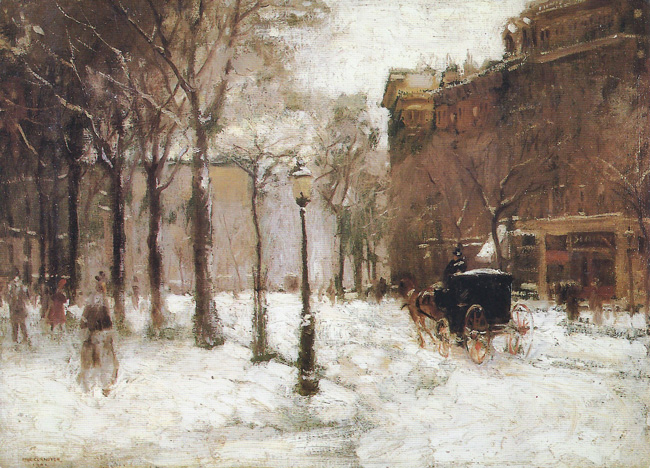PAUL CORNOYER PAINTINGS FOR SALE & BIOGRAPHY
PAUL CORNOYER
American, 1864-1923
BIOGRAPHY
Paul Cornoyer was born in St. Louis, Missouri in 1864 to Charles and Marie Cornoyer, both of French descent. At the age of 17, Cornoyer entered the St. Louis School of Art, whose director, Halsey C. Ives, acted as a mentor for the promising young artist. By 1889, Cornoyer had accumulated sufficient funds to travel to Paris where he entered the Académie Julian and studied with Jules Lefebvre, Louis Blanc and Benjamin Constant.
“But the most profound impact on Cornoyer,” writes Lowell Adams in his introduction to the 1973 exhibition Paul Cornoyer: American Impressionist, “was not the Academy but the great whirlwind of Impressionism which had descended upon Paris during the preceding decade. An aesthetic revolution had enveloped the country and Cornoyer, like many other Americans, would never be the same.
“The artist was fascinated by the European atmosphere, especially in its great cities. Paris, London, and Venice all presented a challenge and the ‘street scene’ was to become his favorite subject. He painted it in bright sun, heavy fog, covered with snow, at sunrise and at dusk.
“Cornoyer returned to his native city in 1894 and subsequently won the gold medal of the St. Louis Association of Painters and Sculptors … In spite of these achievements, Cornoyer could not make his livelihood as an artist in St. Louis. He had sent a painting to the Pennsylvania Academy of the Fine Arts in Philadelphia to be exhibited. It was admired and purchased by the painter William Merritt Chase who in a later correspondence with Cornoyer, urged him to move to New York City. Cornoyer followed his advice, arriving in New York in 1891, and the move was to open a new world for the young artist.
“Cornoyer’s association with Chase led him to the studios of such artists as Thomas Dewing, J. Alden Weir, John Henry Twachtman and Childe Hassam, all great ‘mood’ painters who carried the banner for American Impressionism. In 1902, Cornoyer became a member of the prestigious Salmagundi Club … Cornoyer’s reputation as an artist and teacher continued to grow. In 1908, he was honored with a one-man exhibition at the Albright Art Gallery in Buffalo, New York. The following year he was elected an Associate of the National Academy of Design…
“The artist’s best-known works were the New York City scenes. Cornoyer found great beauty in the city’s streets, buildings and parks. Madison Square was exhibited in Rome in 1911 at the International Art Exhibition and is reminiscent of the early masterpieces of Pissarro. His View in Washington Square shows his ability to paint the figure in the ‘decisive moment’ manner of Degas.” [Lowell Adams, introd., Paul Cornoyer: American Impressionist (exhibition catalogue), Lakeview Center for the Arts and Sciences, Peoria, Illinois, 1973].
In his later years, Cornoyer spent his summers in Gloucester, Massachusetts, where he taught and painted, and was a founder of the North Shore Art Association. He died in Gloucester in 1923.
Museum Collections
Butler Institute of American Art, Youngstown, OH
Dallas Museum of Art, Dallas, TX
Hickory Museum of Art, Hickory, NC
High Museum of Fine Art, Atlanta, GA
Joslyn Museum of Art, Omaha, NE
Nelson-Atkins Museum of Art, Kansas City, MO
Newark Museum, Newark, NJ
Rose Art Museum, Brandeis University, Waltham, MA
Saint Louis Art Museum, St. Louis, MO
Seattle Art Museum, Seattle, WA
Smith College Museum of Art, Northampton, MA
Smithsonian Institution, Washington, DC
Westmoreland Museum of American Art, Greensburg, PA
Yale University Art Gallery, New Haven, CT
Mark Murray Fine Paintings is a New York gallery specializing in buying and selling 19th century and early 20th century artwork.
Please contact us if you are interested in selling your Paul Cornoyer paintings or other artwork from the 19th century and early 20th century.
PAUL CORNOYER
Paintings for sale
Paul Cornoyer Paintings Previously Sold
PAUL CORNOYER
Winter in New York (1901)
Oil on canvas
18 x 24 inches (45.7 x 61 cm)
SOLD
PAUL CORNOYER
Rainy Day, New York
Oil on canvas board
12 x 16 inches (30.5 x 40.8 cm)
SOLD






